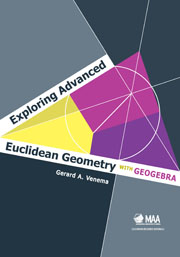Book contents
- Frontmatter
- Preface
- Contents
- 0 A Quick Review of Elementary Euclidean Geometry
- 1 The Elements of GeoGebra
- 2 The Classical Triangle Centers
- 3 Advanced Techniques in GeoGebra
- 4 Circumscribed, Inscribed, and Escribed Circles
- 5 The Medial and Orthic Triangles
- 6 Quadrilaterals
- 7 The Nine-Point Circle
- 8 Ceva's Theorem
- 9 The Theorem of Menelaus
- 10 Circles and Lines
- 11 Applications of the Theorem of Menelaus
- 12 Additional Topics in Triangle Geometry
- 13 Inversions in Circles
- 14 The Poincaré Disk
- References
- Index
- About the Author
11 - Applications of the Theorem of Menelaus
- Frontmatter
- Preface
- Contents
- 0 A Quick Review of Elementary Euclidean Geometry
- 1 The Elements of GeoGebra
- 2 The Classical Triangle Centers
- 3 Advanced Techniques in GeoGebra
- 4 Circumscribed, Inscribed, and Escribed Circles
- 5 The Medial and Orthic Triangles
- 6 Quadrilaterals
- 7 The Nine-Point Circle
- 8 Ceva's Theorem
- 9 The Theorem of Menelaus
- 10 Circles and Lines
- 11 Applications of the Theorem of Menelaus
- 12 Additional Topics in Triangle Geometry
- 13 Inversions in Circles
- 14 The Poincaré Disk
- References
- Index
- About the Author
Summary
The theorem of Menelaus is powerful and has interesting consequences in a variety of situations. This chapter contains a sampling of corollaries.
Tangent lines and angle bisectors
The first applications are simple results about how tangent lines and angle bisectors intersect the sidelines of the triangle. All the proofs in this section rely on the trigonometric form of Menelaus's theorem.
Exercises
*11.1.1. Construct a triangle and its circumscribed circle. For each vertex of the triangle, construct the line that is tangent to the circumcircle at that point. Mark the point at which the line that is tangent at a vertex intersects the opposite sideline of the triangle. Verify that the three points you have marked are collinear. Under what conditions is one or more of the intersection points an ideal point?
11.1.2. Let ΔABC be a triangle. Prove that the lines that are tangent to the circumcircle of ΔABC at the vertices of the triangle cut the opposite sidelines at three collinear points (Figure 11.1).
Hint: Use Euclid's Proposition III.32.
*11.1.3. Construct a triangle ΔABC. At each vertex, construct the line that bisects the two exterior angles at that vertex. Mark the point at which the bisector intersects the opposite sideline. Verify that the three points you have marked are collinear. Under what conditions is one of more of the intersection points an ideal point?
- Type
- Chapter
- Information
- Exploring Advanced Euclidean Geometry with GeoGebra , pp. 85 - 98Publisher: Mathematical Association of AmericaPrint publication year: 2013



